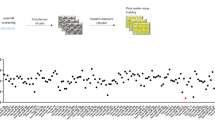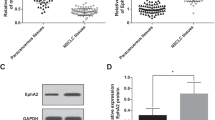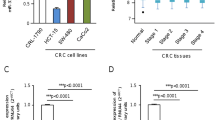Abstract
Small-cell lung cancer (SCLC) is a highly aggressive disease that exhibits rapid growth and genetic instability. We found earlier frequent overexpression of the miR-17–92 microRNA cluster, and showed that SCLC cells were addicted to continued expressions of miR-17–5p and miR-20a, major components of this microRNA cluster. In this study, we identified the frequent presence of constitutively phosphorylated H2AX (γ-H2AX), which reflects continuing DNA damage, preferentially in SCLC. Knockdown of RB induced γ-H2AX foci formation in non-small cell lung cancer (NSCLC) cells with wild-type RB, in association with growth inhibition and reactive oxygen species (ROS) generation, which was canceled by overexpression of miR-17–92. Conversely, induction of γ-H2AX was observed in a miR-17–92-overexpressing SCLC cell line with miR-20a antisense oligonucleotides. These findings suggest that miR-17–92 overexpression may serve as a fine-tuning influence to counterbalance the generation of DNA damage in RB-inactivated SCLC cells, thus reducing excessive DNA damage to a tolerable level and consequently leading to genetic instability. Therefore, miR-17–92 may be an excellent therapeutic target candidate to elicit excessive DNA damage in combination with DNA-damaging chemotherapeutics.
This is a preview of subscription content, access via your institution
Access options
Subscribe to this journal
Receive 50 print issues and online access
$259.00 per year
only $5.18 per issue
Buy this article
- Purchase on Springer Link
- Instant access to full article PDF
Prices may be subject to local taxes which are calculated during checkout





Similar content being viewed by others
References
Bartkova J, Horejsi Z, Koed K, Kramer A, Tort F, Zieger K et al. (2005). DNA damage response as a candidate anti-cancer barrier in early human tumorigenesis. Nature 434: 864–870.
Chowdhury D, Keogh MC, Ishii H, Peterson CL, Buratowski S, Lieberman J . (2005). gamma-H2AX dephosphorylation by protein phosphatase 2A facilitates DNA double-strand break repair. Mol Cell 20: 801–809.
DiTullio Jr RA, Mochan TA, Venere M, Bartkova J, Sehested M, Bartek J et al. (2002). 53BP1 functions in an ATM-dependent checkpoint pathway that is constitutively activated in human cancer. Nat Cell Biol 4: 998–1002.
Ebi H, Matsuo K, Sugito N, Suzuki M, Osada H, Tajima K et al. (2007). Novel NBS1 heterozygous germ line mutation causing MRE11-binding domain loss predisposes to common types of cancer. Cancer Res 67: 11158–11165.
Gorgoulis VG, Vassiliou LV, Karakaidos P, Zacharatos P, Kotsinas A, Liloglou T et al. (2005). Activation of the DNA damage checkpoint and genomic instability in human precancerous lesions. Nature 434: 907–913.
Halazonetis TD, Gorgoulis VG, Bartek J . (2008). An oncogene-induced DNA damage model for cancer development. Science 319: 1352–1355.
Hayashita Y, Osada H, Tatematsu Y, Yamada H, Yanagisawa K, Tomida S et al. (2005). A polycistronic microRNA cluster, miR-17–92, is overexpressed in human lung cancers and enhances cell proliferation. Cancer Res 65: 9628–9632.
Inomata M, Tagawa H, Guo YM, Kameoka Y, Takahashi N, Sawada K . (2009). MicroRNA-17–92 down-regulates expression of distinct targets in different B-cell lymphoma subtypes. Blood 113: 396–402.
Johnson SM, Grosshans H, Shingara J, Byrom M, Jarvis R, Cheng A et al. (2005). RAS is regulated by the let-7 microRNA family. Cell 120: 635–647.
Konishi H, Nakagawa T, Harano T, Mizuno K, Saito H, Masuda A et al. (2002). Identification of frequent G(2) checkpoint impairment and a homozygous deletion of 14–3–3epsilon at 17p13.3 in small cell lung cancers. Cancer Res 62: 271–276.
Lu Y, Thomson JM, Wong HY, Hammond SM, Hogan BL . (2007). Transgenic over-expression of the microRNA miR-17–92 cluster promotes proliferation and inhibits differentiation of lung epithelial progenitor cells. Dev Biol 310: 442–453.
Matsubara H, Takeuchi T, Nishikawa E, Yanagisawa K, Hayashita Y, Ebi H et al. (2007). Apoptosis induction by antisense oligonucleotides against miR-17–5p and miR-20a in lung cancers overexpressing miR-17–92. Oncogene 26: 6099–6105.
Nakagawa T, Hayashita Y, Maeno K, Masuda A, Sugito N, Osada H et al. (2004). Identification of decatenation G2 checkpoint impairment independently of DNA damage G2 checkpoint in human lung cancer cell lines. Cancer Res 64: 4826–4832.
Nuciforo PG, Luise C, Capra M, Pelosi G, d’Adda di Fagagna F . (2007). Complex engagement of DNA damage response pathways in human cancer and in lung tumor progression. Carcinogenesis 28: 2082–2088.
O’Donnell KA, Wentzel EA, Zeller KI, Dang CV, Mendell JT . (2005). c-Myc-regulated microRNAs modulate E2F1 expression. Nature 435: 839–843.
Petrocca F, Visone R, Onelli MR, Shah MH, Nicoloso MS, de Martino I et al. (2008). E2F1-regulated microRNAs impair TGFbeta-dependent cell-cycle arrest and apoptosis in gastric cancer. Cancer Cell 13: 272–286.
Pickering MT, Kowalik TF . (2006). Rb inactivation leads to E2F1-mediated DNA double-strand break accumulation. Oncogene 25: 746–755.
Pickering MT, Stadler BM, Kowalik TF . (2009). miR-17 and miR-20a temper an E2F1-induced G1 checkpoint to regulate cell cycle progression. Oncogene 28: 140–145.
Powers JT, Hong S, Mayhew CN, Rogers PM, Knudsen ES, Johnson DG . (2004). E2F1 uses the ATM signaling pathway to induce p53 and Chk2 phosphorylation and apoptosis. Mol Cancer Res 2: 203–214.
Putzer BM . (2007). E2F1 death pathways as targets for cancer therapy. J Cell Mol Med 11: 239–251.
Sekido Y, Fong KM, Minna JD . (2003). Molecular genetics of lung cancer. Annu Rev Med 54: 73–87.
Taguchi A, Yanagisawa K, Tanaka M, Cao K, Matsuyama Y, Goto H et al. (2008). Identification of hypoxia-inducible factor-1 alpha as a novel target for miR-17–92 microRNA cluster. Cancer Res 68: 5540–5545.
Takamizawa J, Konishi H, Yanagisawa K, Tomida S, Osada H, Endoh H et al. (2004). Reduced expression of the let-7 microRNAs in human lung cancers in association with shortened postoperative survival. Cancer Res 64: 3753–3756.
Tanaka H, Matsumura I, Ezoe S, Satoh Y, Sakamaki T, Albanese C et al. (2002). E2F1 and c-Myc potentiate apoptosis through inhibition of NF-kappaB activity that facilitates MnSOD-mediated ROS elimination. Mol Cell 9: 1017–1029.
Tokumaru S, Suzuki M, Yamada H, Nagino M, Takahashi T . (2008). let-7 regulates Dicer expression and constitutes a negative feedback loop. Carcinogenesis 29: 2073–2077.
Tort F, Bartkova J, Sehested M, Orntoft T, Lukas J, Bartek J . (2006). Retinoblastoma pathway defects show differential ability to activate the constitutive DNA damage response in human tumorigenesis. Cancer Res 66: 10258–10263.
Ventura A, Young AG, Winslow MM, Lintault L, Meissner A, Erkeland SJ et al. (2008). Targeted deletion reveals essential and overlapping functions of the miR-17 through 92 family of miRNA clusters. Cell 132: 875–886.
Wang SS, Esplin ED, Li JL, Huang L, Gazdar A, Minna J et al. (1998). Alterations of the PPP2R1B gene in human lung and colon cancer. Science 282: 284–287.
Acknowledgements
This work was financially supported in part by a Grant-in-Aid for Scientific Research on priority areas from the Ministry of Education, Culture, Sports, Science and Technology of Japan, a Grant-in-Aid for Scientific Research from the Japan Society for the Promotion of Science, and a Grant (07–23903) from the Princess Takamatsu Cancer Research Fund. HE was supported by the IASLC fellowship of the International Association for the Study of Lung Cancer (IASLC) during this study.
Author information
Authors and Affiliations
Corresponding author
Additional information
Supplementary information accompanies the paper on the Oncogene website (http://www.nature.com/onc)
Supplementary information
Rights and permissions
About this article
Cite this article
Ebi, H., Sato, T., Sugito, N. et al. Counterbalance between RB inactivation and miR-17–92 overexpression in reactive oxygen species and DNA damage induction in lung cancers. Oncogene 28, 3371–3379 (2009). https://doi.org/10.1038/onc.2009.201
Received:
Revised:
Accepted:
Published:
Issue Date:
DOI: https://doi.org/10.1038/onc.2009.201
Keywords
This article is cited by
-
Revisiting cancer hallmarks: insights from the interplay between oxidative stress and non-coding RNAs
Molecular Biomedicine (2020)
-
Crosstalk between noncoding RNAs and ferroptosis: new dawn for overcoming cancer progression
Cell Death & Disease (2020)
-
Mitochondrial miR-762 regulates apoptosis and myocardial infarction by impairing ND2
Cell Death & Disease (2019)
-
The dynamical roles of miR-17-92 on the E2F-related network during the G1/S transition
Nonlinear Dynamics (2019)
-
Splicing regulator SLU7 preserves survival of hepatocellular carcinoma cells and other solid tumors via oncogenic miR-17-92 cluster expression
Oncogene (2016)



